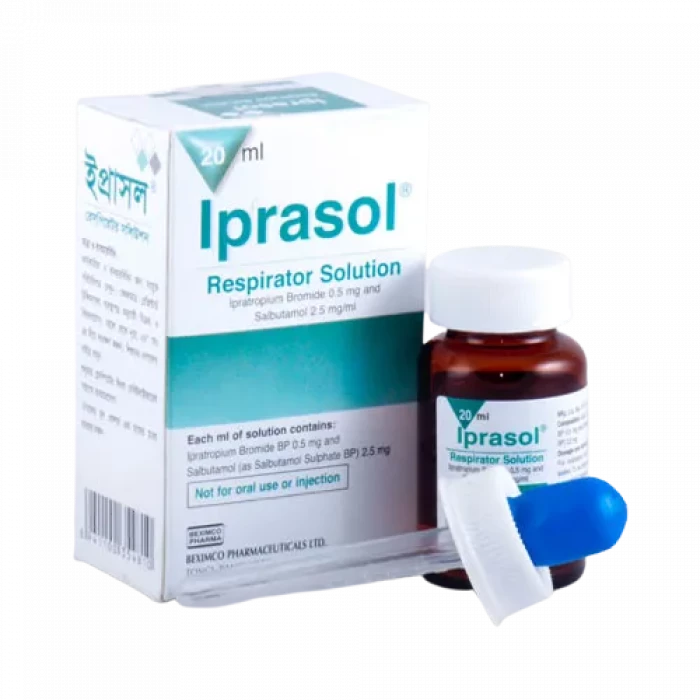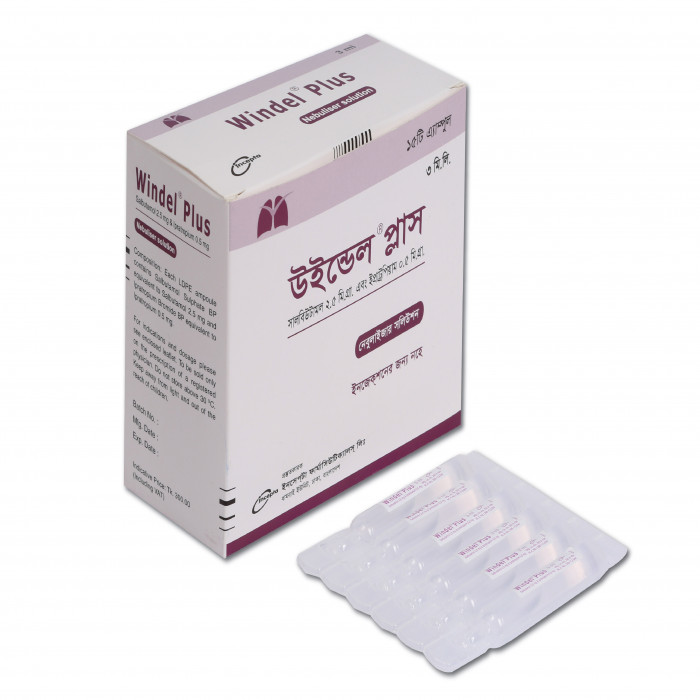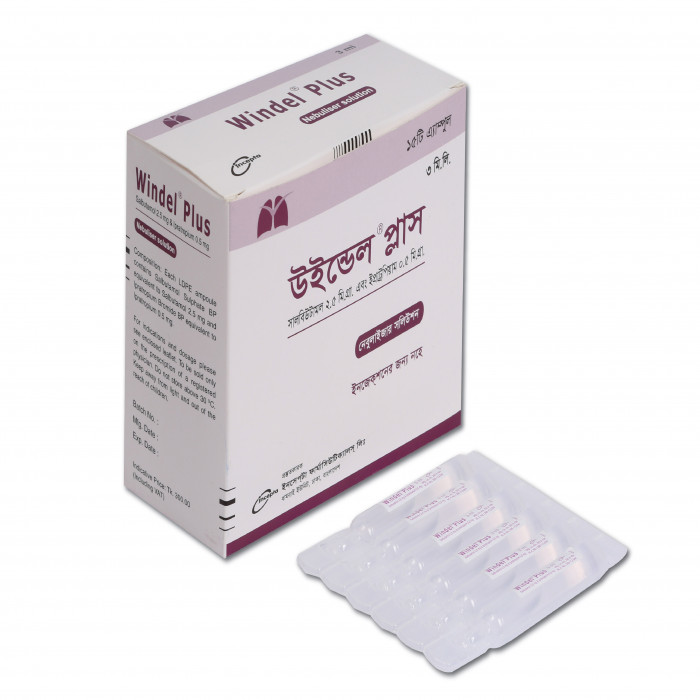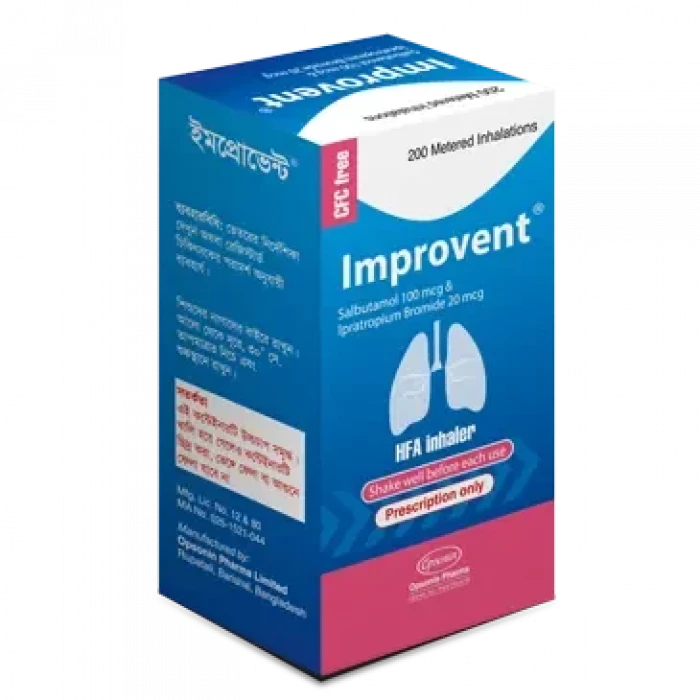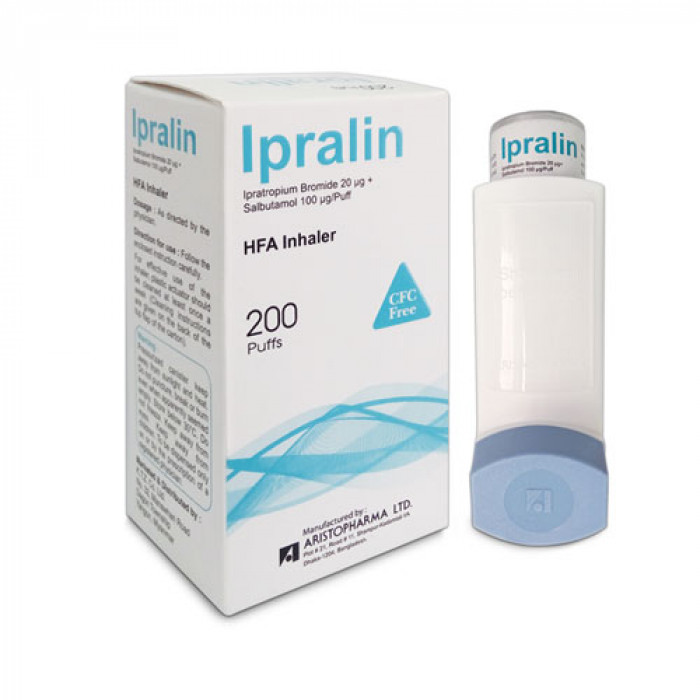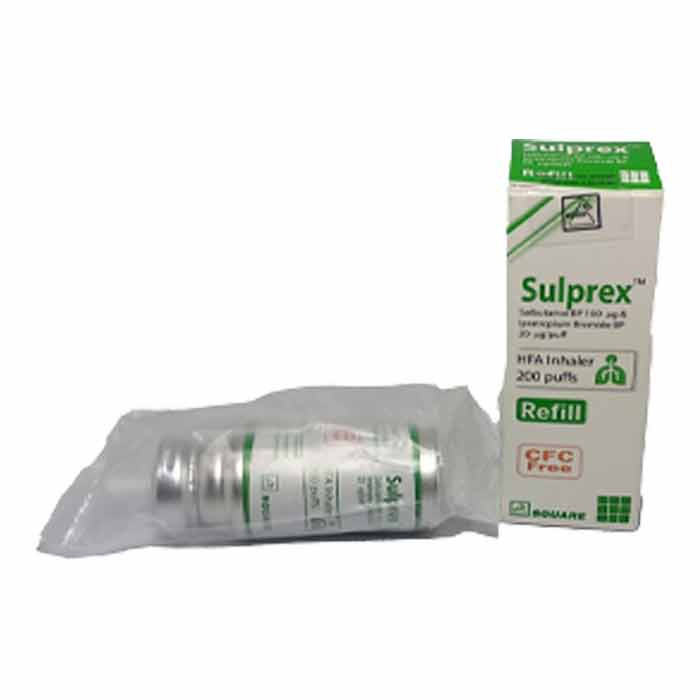
✔ 100% Authentic Product
👁️ Currently Viewing 2910
Sulprex HFA Refill | (100mcg+20mcg)/puff
Sulprex Inhalation Aerosol is prescribed for patients with chronic obstructive pulmonary disease (COPD) who are already using a regular inhaled bronchodilator but continue to experience signs of bronchospasm. It is intended for individuals who require an additional bronchodilator to achieve better control of symptoms.
- Use cautiously in patients with narrow-angle glaucoma, prostatic enlargement, or bladder-neck obstruction (due to Ipratropium).
- Use cautiously in those with seizure disorders, hyperthyroidism, diabetes, or unusual sensitivity to sympathomimetic drugs (due to Salbutamol).
Discount
Price: ৳ 217
MRP:
৳
231
6%
Off

100% Genuine Products, Guaranteed

Safe & Secure Payments, Always

Fast, Secure & Efficient Delivery

Proper Packaging
 Cash on Delivery - All over Bangladesh
Cash on Delivery - All over Bangladesh Regular Delivery - 12-24 Hours, Dhaka City* Charge Tk.39-59
Regular Delivery - 12-24 Hours, Dhaka City* Charge Tk.39-59 Regular Delivery - 24-48 Hours, Other Cities* Charge Tk.99-110
Regular Delivery - 24-48 Hours, Other Cities* Charge Tk.99-110
 ফ্রি ডেলিভারিঃ - ৯৯৯ টাকা+ অর্ডারে, ঢাকা
শহরে
ফ্রি ডেলিভারিঃ - ৯৯৯ টাকা+ অর্ডারে, ঢাকা
শহরে ফ্রি ডেলিভারিঃ - ২৯৯৯ টাকা+ অর্ডারে, ঢাকার
বাহিরে
ফ্রি ডেলিভারিঃ - ২৯৯৯ টাকা+ অর্ডারে, ঢাকার
বাহিরে
100% Genuine Products, Guaranteed
Safe & Secure Payments, Always
Fast, Secure & Efficient Delivery
Proper Packaging
 Cash on Delivery - All over Bangladesh
Cash on Delivery - All over Bangladesh Regular Delivery - 12-24 Hours, Dhaka City* Charge Tk.39-59
Regular Delivery - 12-24 Hours, Dhaka City* Charge Tk.39-59 Regular Delivery - 24-48 Hours, Other Cities* Charge Tk.99-110
Regular Delivery - 24-48 Hours, Other Cities* Charge Tk.99-110 ফ্রি ডেলিভারিঃ - ৯৯৯ টাকা+ অর্ডারে, ঢাকা
শহরে
ফ্রি ডেলিভারিঃ - ৯৯৯ টাকা+ অর্ডারে, ঢাকা
শহরে ফ্রি ডেলিভারিঃ - ২৯৯৯ টাকা+ অর্ডারে, ঢাকার
বাহিরে
ফ্রি ডেলিভারিঃ - ২৯৯৯ টাকা+ অর্ডারে, ঢাকার
বাহিরে
✅ Description:
Sulprex is a combination inhalation aerosol containing two active ingredients:
- Salbutamol (as sulphate) – a short-acting β₂-adrenergic bronchodilator that relaxes bronchial smooth muscle and improves airflow.
- Ipratropium bromide – an anticholinergic bronchodilator that inhibits the muscarinic action of acetylcholine on bronchial smooth muscle, thereby preventing an increase in intracellular cyclic GMP.
Together, they provide bronchodilation via two distinct mechanisms:
Anticholinergic (parasympatholytic) action from Ipratropium bromide.
Sympathomimetic action from Salbutamol.
This combination often results in greater and more sustained relief from bronchospasm compared to using either drug alone at standard doses.
The product uses HFA (hydrofluoroalkane) as an eco-friendly propellant instead of CFCs (chlorofluorocarbons), which are harmful to the ozone layer.
✔️ Overdose & Possible Side Effects
Overdose
Most likely due to the Salbutamol component, symptoms may include chest pain (angina), high blood pressure, low potassium (hypokalemia), and rapid heartbeat (tachycardia).
Possible Side Effects
From Salbutamol: mild tremor, headache (usually resolves with continued use), rare muscle cramps, allergic reactions (angioedema, urticaria, bronchospasm, hypotension).
From Ipratropium bromide: rare headache, flu-like symptoms, chest pain, nausea, difficulty breathing, cough, throat irritation, sinusitis.
✔️ Dosage & Administration
Adults (including the elderly): 2 puffs, four times daily.
Extra puffs may be taken if needed, but do not exceed 12 puffs in 24 hours.
Follow the prescribing doctor’s instructions carefully.
(Use only under the guidance of a registered physician.)
Administration Guidelines
Using an inhaler properly is crucial; incorrect technique can lead to less medicine reaching the lungs. Correct use helps prevent or reduce the severity of asthma or COPD attacks.
Recommended steps (as per the National Asthma Guidelines):
- Remove the cap from the inhaler.
- Shake the inhaler vigorously at least six times before use.
- If new or unused for over a week, shake and release one test puff into the air.
- Breathe out fully and hold the inhaler upright.
- Place the mouthpiece between your teeth, closing your lips tightly around it.
- Start inhaling slowly and deeply through your mouth while pressing down firmly on the canister to release the medicine.
- Remove the inhaler and hold your breath for at least 10 seconds (or as long as comfortable).
- If a second puff is prescribed, wait 1 minute before repeating steps 4–7.
- Replace the cap and rinse your mouth with water after use.
Technique check: Use a mirror occasionally; if you see white mist escaping, your lips may not be sealed or you may be pressing too early/late—repeat correctly.
Cleaning: Once a week, remove the metal canister, rinse the plastic actuator and cap in warm water (never immerse the canister in water), dry thoroughly, and reassemble.
✔️ Drug Interactions
Sulprex can be used alongside other COPD medicines such as sympathomimetic bronchodilators, methylxanthines, and steroids, but caution is advised:
Use carefully with other anticholinergic agents or sympathomimetic drugs to avoid excessive cardiovascular side effects.
Beta-2 agonists like Salbutamol should be used cautiously with non–non-potassium-sparing diuretics, monoamine oxidase inhibitors, or tricyclic antidepressants due to possible interactions.
✔️ Contraindications
Allergy to Soya-lecithin, soybean, peanut, or related food products.
Hypersensitivity to atropine (or its derivatives) or any components of the product.
✔️ Pregnancy & Lactation
Ipratropium bromide: Pregnancy category B (animal studies show no harm to fetus).
Salbutamol: Pregnancy category C (animal studies show teratogenic effects).
Use in pregnancy only if potential benefits outweigh risks. Unknown if excreted in human milk; caution is advised for breastfeeding mothers.
✔️ Storage
- Keep away from heat, sunlight, and children.
- Do not puncture, burn, or expose the canister to high temperatures, even when empty.
- Store in a cool, dry place.
- Keep away from the eyes.
⚠️Disclaimer:
At ePharma, we’re committed to providing accurate and accessible health information. However, all content is intended for informational purposes only and should not replace medical advice from a qualified physician. Please consult your healthcare provider for personalized guidance. We aim to support, not substitute, the doctor-patient relationship.




